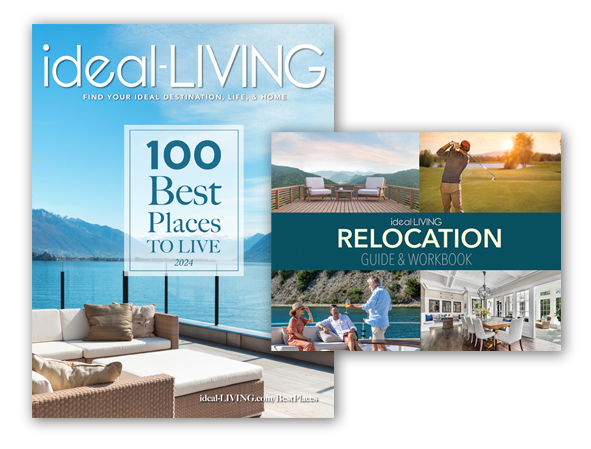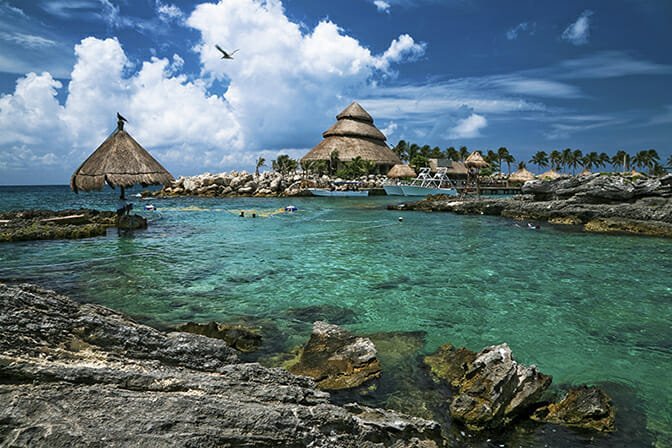
A Crown Jewel of Nature: Explore Mexico’s Riviera Maya
A Crown Jewel of Nature: Explore Mexico’s Riviera Maya
Years ago, I traveled with my family to the new and intriguing Mexican resort of Cancún, a collection of a mere dozen hotels along the Atlantic coast. 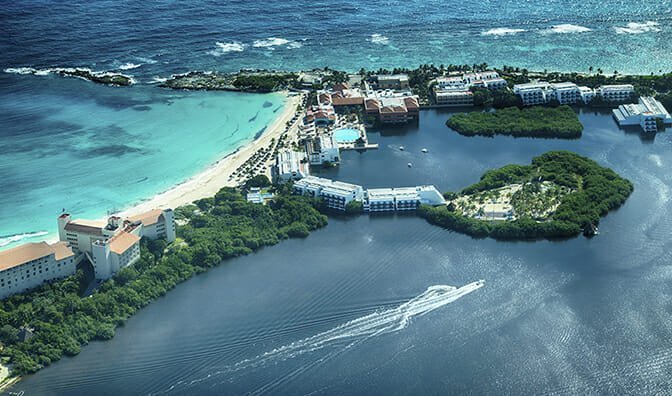 The attraction for us as North American visitors was a warm, hospitable vacation at affordable prices. Once there, we took a rickety ferry to Isla Mujeres, the Island of Women, and wandered the streets filled with native merchants, then later swam off the reef at the end of the island. Another day, we rented a frighteningly ancient car and drove west for a couple of hours to one of the great wonders of the world, the Mayan ruins of Chichen Itza, a must-see for anyone traveling the area. A few other days were spent driving down a blacktop, two-lane highway to Puerto Aventuras then taking a rusty ferry to the Island of Cozumel. But most of the time, we relaxed for long, lazy days in the sun and ate in restaurant huts on the beach. We felt like adventurers exploring and enjoying an untouched area of the world.
The attraction for us as North American visitors was a warm, hospitable vacation at affordable prices. Once there, we took a rickety ferry to Isla Mujeres, the Island of Women, and wandered the streets filled with native merchants, then later swam off the reef at the end of the island. Another day, we rented a frighteningly ancient car and drove west for a couple of hours to one of the great wonders of the world, the Mayan ruins of Chichen Itza, a must-see for anyone traveling the area. A few other days were spent driving down a blacktop, two-lane highway to Puerto Aventuras then taking a rusty ferry to the Island of Cozumel. But most of the time, we relaxed for long, lazy days in the sun and ate in restaurant huts on the beach. We felt like adventurers exploring and enjoying an untouched area of the world.
As the years went by, more and more people discovered the incomparable charms of this part of Mexico.  Resorts began to spread south from Cancún along seemingly endless beaches and pristine real estate. Now, over one million Americans and Canadians are living on the Atlantic coast of Mexico. Cancún is the number one vacation destination in all of Latin America, with the Riviera Maya following as number two. People are coming, falling in love with Mexico and staying. They are expats who have made the transition to a warm, embracing climate with endless charms.
Resorts began to spread south from Cancún along seemingly endless beaches and pristine real estate. Now, over one million Americans and Canadians are living on the Atlantic coast of Mexico. Cancún is the number one vacation destination in all of Latin America, with the Riviera Maya following as number two. People are coming, falling in love with Mexico and staying. They are expats who have made the transition to a warm, embracing climate with endless charms.
Today, the 127-miles between Cancún and Sian Ka’an hold some 356 hotels and counting. And it’s no wonder. The area is filled with natural marvels, ecological reserves, emerald green jungles, turquoise, blue seas, plus almost countless lost cities of the ancient Mayan civilization, cities buried by dirt and jungle only now being discovered and unearthed. Because of these wildly diverse attractions, the Riviera Maya is like no other place. Where else can you explore the fantasy world of the Mayan ruins of Chichen Itza, Tulum or the huge, almostuntouched, site of Coba, then swim in a warm turquoise ocean before having dinner in a world-class restaurant?
“When we consider an ideal beach scene, Tulum definitely competes for top honors. White sand, fabulously blue water, not overrun, no giant resorts 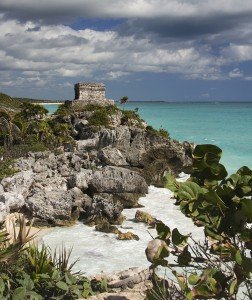 or heavy development along the beach. Just beautiful,” said Audry Scott in her travel blog.
or heavy development along the beach. Just beautiful,” said Audry Scott in her travel blog.
The white sand beaches and electric blue waters are an almost universal draw to the entire area.
It goes on and on: golf, tennis, diving on the world’s second longest reef, sailing, fishing and exploring until you drop from sheer exhaustion for a night’s sleep under a crystal clear Mexican sky. Even though there has been enormous expansion in recent years, Mexico wants to protect this crown jewel of nature. Careful resort planning has been a primary government objective, with infrastructure improvements in roads, electricity, water treatment and communications.
“Sustainability initiatives are happening at all levels of tourism. Cancún-area developers and hoteliers have recognized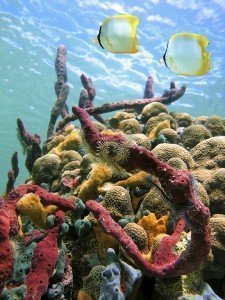 the turning tide and are taking active steps to address environmental impacts and integrate local culture into their operations,” says Angela Dollar in her blog.
the turning tide and are taking active steps to address environmental impacts and integrate local culture into their operations,” says Angela Dollar in her blog.
With all this said, what is it really like? There are some far-sighted people who were unable to resist this lifestyle once they had experienced it—people who made the decision to stay.
A two-year resident at the Tao Residential Community in Akumal, Anne deBose and her husband made the move from Texas, choosing a three-bedroom home close to the beach and a Robert Trent Jones golf course to satisfy their individual and collective desires.
“The community here is mostly Canadians and Americans and a small percentage of Europeans. I would say many of our friends here are new expats,” deBose says. “Our community is great. Most of the owners don’t live here full time. The mix of people is constantly changing as people come and go during the year. The Tao Community is very active in putting on different events during the month like excursions, cooking classes, lunches, Spanish lessons, etc. for those who are here and would like to participate.”
But there’s more to consider about the Riviera Maya than just beauty, natural attractions and amenity-loaded communities. Here are a few practical suggestions if you’re considering a move or the purchase of real estate.
Getting There and Getting Around
Coming to the area, you’ll probably use the International Airport in Cancún (CUN) that has hundreds of daily flights 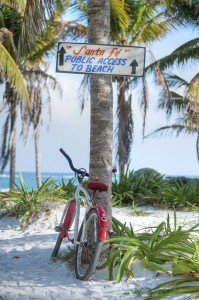 to and from 21 cities in the United States and seven cities in Canada. For most of these cities, there are multiple daily flights, giving you a good choice of departure and arrival times.
to and from 21 cities in the United States and seven cities in Canada. For most of these cities, there are multiple daily flights, giving you a good choice of departure and arrival times.
Once there, having a car is helpful, but there are local transportation options that can get you where you wish to go using the collectivos and buses. Bike or scooter riding is the most simple and economical way to get around and the way a lot of young people prefer to travel.
Considering a Purchase?
If you’re considering buying a home in the Riviera Maya, you’ll find that they’re much more affordable if you don’t choose the most expensive location, like close to the beach. Property taxes basically cost pennies compared to the United States. New homes and condo developments are being built with American and Canadian values as
developers and architects do all they can to meet North American standards. An important consideration for a foreign purchaser of Mexican real estate is to become well-educated about the buying process before making a commitment. Visit, stay in a community for a few weeks to see if it meets your requirements and do your homework.
That’s what Anne deBose and her husband did. “By the end of our first day in Tao, I knew that this was going to be our future home,” deBose says. “The beaches are perfect (my requirement) and there’s a Robert Trent golf course (husband’s requirement). After dinner on our first night here, my husband and I were sitting on our patio of the hotel enjoying the beautiful evening, and he said to me, ‘Do you think you could live here?’ and I said, ‘DEFINITELY!’ I call this my paradise!”
Medical Care
Health is always a concern when moving to a foreign country. Even though the sunshine and warm weather can contribute to a healthy and active l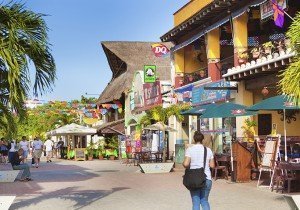 ifestyle, there are always those unplanned emergencies. Mexico has a social security system that is free for Mexicans as well as foreign nationals with Residente Permanente status. Foreigners living in Mexico without full-immigrated residency status can usually purchase health insurance for about $300 USD a year. According to Cecilia Mosqueda of The Fives in Playa Del Carmen, “The area is also known for its medical tourism. People come here to have medical procedures and recuperate in amazing surroundings of the Riviera Maya.”
ifestyle, there are always those unplanned emergencies. Mexico has a social security system that is free for Mexicans as well as foreign nationals with Residente Permanente status. Foreigners living in Mexico without full-immigrated residency status can usually purchase health insurance for about $300 USD a year. According to Cecilia Mosqueda of The Fives in Playa Del Carmen, “The area is also known for its medical tourism. People come here to have medical procedures and recuperate in amazing surroundings of the Riviera Maya.”
Cost of Living
The subject of cost of living always comes up. Depending upon your standards and circumstances, you can live as inexpensively or as lavishly as you wish. However, basic commodities are similar no matter what your economic position. There are reliable telecommunication services, internet, modern malls and convenient banking, which can be used to access your home banking accounts. ATM machines that dispense both pesos and dollars are everywhere. With the low cost of labor, it’s easy to find help with housekeeping, gardening and maintenance, services that are more affordable than in North America.
Mail delivery is often problematic, which leads many to go paperless and pay their U.S. bills online. But, buying products online is more difficult. UPS and FedEx are available, but are expensive if you wish to bring in items from the U.S. or Canada. There are shops that will accept a package for you for a nominal fee once your foreign purchase clears Mexican customs. Most services and products you’re familiar with are comparable, with a large percentage of goods available that you would normally buy up north. However, imports are generally more expensive than Mexican products. Like it or not, you’ll find many familiar stores like Costco, Sam’s Club, OfficeMax, FedEx, UPS, DHL, Home Depot, Starbucks, Haagen Daz, McDonald’s, Burger King and Wal-Mart. Fortunately, there are numerous English-speaking movies available.
Recent gas prices were somewhat over $3 USD per gallon. Produce is 50 to 70 percent cheaper than in the U.S. Local fresh foods such as fish, eggs and pork are the most affordable way to eat. When dining out, you can go to local eateries and have a healthy me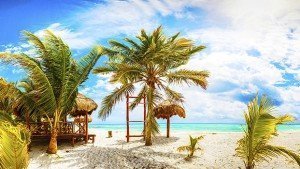 al for around 50 pesos or about $4.50 USD. Dining on the beach or at a more upscale restaurant will be more expensive, and the prices range from 100 pesos to 300 pesos or more. After breaking it all down, it’s possible to live on about 30 percent less than you can in an average U.S. city. That said, the most expensive utility in Mexico is electricity, the reason stores often leave their lights off until a customer walks in.
al for around 50 pesos or about $4.50 USD. Dining on the beach or at a more upscale restaurant will be more expensive, and the prices range from 100 pesos to 300 pesos or more. After breaking it all down, it’s possible to live on about 30 percent less than you can in an average U.S. city. That said, the most expensive utility in Mexico is electricity, the reason stores often leave their lights off until a customer walks in.
Anne deBose says, “We own our home, so the cost of rent doesn’t play a factor in our expenses. Food, water and gas are very inexpensive, but electricity is very expensive. Our typical monthly budget is under $3,000 USD per month and that’s living quite well. When we compared our budgets in Mexico and the U.S., our U.S. budget was close to double.”
Between the inviting cities of Playa del Carmen and Tulum, you’ll find the enchanting resort community of Bahia Principe. According to Eduardo Muñoz of Bahia Principe, “You can find everything you need for a second home or retirement destination within the resort gates with a great cost of living.”
An impressive gated community, Bahia Principe is complete with two Robert Trent Jones golf courses, and homeowners can enjoy the full resort privileges of the Bahia Principe Riviera Maya complex. Bahia Principe offers home ownership through its condos and single-family custom homes. They offer a complete turn-key service that enables you to choose the lifestyle you desire with ease. When asked about the safety of the area, Muñoz replies with a smile, “It is very safe within the gates of the community, however, it remains safe outside of the gates. The Riviera Maya is safer than many places in the U.S.”
By William Burr. Previously published in the 2015 Spring Issue
Receive your complimentary Relocation guide and magazine
